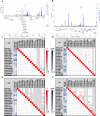Whole genome sequencing in the Middle Eastern Qatari population identifies genetic associations with 45 clinically relevant traits
- PMID: 33623009
- PMCID: PMC7902658
- DOI: 10.1038/s41467-021-21381-3
Whole genome sequencing in the Middle Eastern Qatari population identifies genetic associations with 45 clinically relevant traits
Abstract
Clinical laboratory tests play a pivotal role in medical decision making, but little is known about their genetic variability between populations. We report a genome-wide association study with 45 clinically relevant traits from the population of Qatar using a whole genome sequencing approach in a discovery set of 6218 individuals and replication in 7768 subjects. Trait heritability is more similar between Qatari and European populations (r = 0.81) than with Africans (r = 0.44). We identify 281 distinct variant-trait-associations at genome wide significance that replicate known associations. Allele frequencies for replicated loci show higher correlations with European (r = 0.94) than with African (r = 0.85) or Japanese (r = 0.80) populations. We find differences in linkage disequilibrium patterns and in effect sizes of the replicated loci compared to previous reports. We also report 17 novel and Qatari-predominate signals providing insights into the biological pathways regulating these traits. We observe that European-derived polygenic scores (PGS) have reduced predictive performance in the Qatari population which could have implications for the translation of PGS between populations and their future application in precision medicine.
Conflict of interest statement
The authors declare no competing interests.
Figures





References
Publication types
MeSH terms
LinkOut - more resources
Full Text Sources
Other Literature Sources

